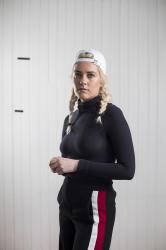“We are so imperfect,” director Baldvin Z says carefully, focused entirely on choosing the right words. “We make so many bad decisions in our lives and I am fascinated by them. Our human side is so flawed. I think that’s the element I am always searching for.”
This theme was dissected intimately in his most famous work, 2014’s ‘Vonarstæti’, but he returns to it now in his newest piece, ‘Lof mér að falla’ (‘Let Me Fall’), which explores the phenomenon and aftermath of Iceland’s mid-2000s ‘týndu stúlkurnar’ (‘lost girls’).

Where are they?
‘Lost girls’ is an anglicization of an epidemic that rocked the mid-2000s in Iceland, where teenage girls began to vanish into the ether. “It was so strange to see this every week in the paper. She is missing. Now she is missing,” Baldvin says. “I always wondered, where are they? We are on a tiny island so it’s not like they are gone forever. What is going on?”
It was only brought to light years later that these girls had become swept up into the underworld of Icelandic society—engulfed in drugs, homelessness, and prostitution—so much so that they were effectively untraceable. In a number of exposés and interviews in Icelandic newspapers in years since, girls who had gotten out of that lifestyle told fragments of their stories. That said, the intimate details surrounding their lives are still somewhat under wraps. There is not much written on the internet or academic papers and much of what Icelanders know is simply hearsay.
A few years ago, Baldvin came into contact with diaries from a ‘lost girl’ who has since died. “These diaries were 13 or 14 years old and they were so mind-blowing in many ways,” he explains. He then connected with three women who had also been caught up in that lifestyle and interviewed them. “When they started to tell us what they were doing, we just couldn’t believe it,” Baldvin says, visibly incredulous. “There is a world of human trafficking in Iceland, which is different than the US, but it is here. They are trafficking girls for drugs, prostitution, and money.”
A proclivity to extremity
Baldvin believes much of this darkness relates back to the Icelandic psyche, which he says naturally drifts towards extremity. “In the diary, the girl writes herself, ‘If I am going to be an addict, I am gonna be the best one,’” Baldvin relays. “It is in our upbringing or something. We don’t do anything half-way. We must do everything all the way.”

He also connects it to economic growth. “When a boom happens, everything gets bigger,” he says. “Drugs, houses, cars; something crazy happens. If you look at people that go into psychiatric hospitals, there is a connection between economic growth and that area.” He pauses. “It makes total sense: more money, more drugs, more craziness. When we get this big economic growth, everything goes to hell.”
Addiction conquers
The film tells the story of two girls, Magnea and Stella. Magnea is a 15-year-old suburban kid, who meets Stella and becomes fascinated by the dangerous world in which she lives. “So we’re watching Stella lure her into this world of drugs and dangerous living,” Baldvin explains.
The story moves with them for three years as ‘lost girls’ but then dives into their lives 15-years later, with the two women having gone in totally different directions. “There is something they need to talk about, which took place 15 years before, so they have to have a showdown,” Baldvin says, smiling. “I cannot tell you more or I will spoil the film.”
Much of the story was inspired directly from the three girls he interviewed. “The thing is, they didn’t know about each other. We interviewed them separately,” Baldvin explains. “But we realised that two of them were actually talking about each other and the things they did to each other are just incredible.” He pauses; it’s clear he finds the topic at hand both fascinating but also upsetting. “It was a betrayal that was so huge.”
For Baldvin, this solidified his interest in the story. “I am fascinated by people’s capacity to do wrong. But that story summed up how addiction can be so incredibly selfish, emotionless, and nasty,” he says. “In the film, they are in love but are still ready to do this to each other. Addiction conquers everything.”
A new crisis
While the film explores a specific time period in Icelandic history, it has a special relevance to the modern day, as Iceland is currently going through an Opioid epidemic. While Baldvin sees certain similarities between the two situations—such as the proclivity of Icelanders to extremity—he’s hesitant to say that they directly mirror each other. “There are differences, and the film is not about drugs, it is about who is in this world, and their relationships and families and the aftermath and how you go from there into being a normal person again,” he explains.
Moreover, Baldvin believes that this current drug climate has a very different context than that of the ‘lost girls’. “The crazy thing that is happening now is that we are seeing kids dying that are not addicted to drugs,” Baldvin adds. “They are going out, drinking some beers, and taking some Oxycontin or Xanax or something and just dying. It’s a new kind of drug abuse that we have never seen before.”
Above all else, Baldvin sees addiction as something that concerns everyone regardless of the current climate. “Drugs don’t ask about age, nationality, colour, or where you are from,” he says. He hopes his story will help people understand this dangerous world more. “It is heavy,” he says. “But in the end, it is just a story, it is just a film, and I hope that it will do good things.”
Buy subscriptions, t-shirts and more from our shop right here!
















